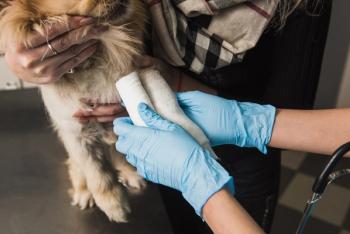
What you need to know to treat heat stroke and keep your cool

Erik Zager, DVM, DACVECC, explained the dangers of heat stroke and discussed treatment options
As with humans, heat stroke in animals is a dangerous medical condition that requires emergency treatment. If left untreated or treatment is delayed, heat stroke can cause serious complications or even death. In a session titled “Heat Stroke”1 presented at Fetch dvm360® conference in Kansas City, Missouri, Erik Zager, DVM, DACVECC, broke down how heat stroke affects the body and walked through treatment options for general practitioners. Throughout the presentation, Zager stressed the consequences of not responding quickly and decisively to heat stroke.
How heat stroke affects the body
Zager defined heatstroke as “a form of hyperthermia associated with a systemic inflammatory response, leading to a syndrome of multiorgan dysfunction in which encephalopathy predominates.” To defend against high temperatures, Zager stated that the body has natural “heat shock proteins” that can be activated by even mild hyperthermia. These proteins have additional functions, Zager explained: “They modulate the immune system, so they decrease proinflammatory cytokines, [and] they increase anti-inflammatory cytokines.” However, these heat stock proteins can only protect the body so much and will die if body temperature is too high.
Zager explains that in early heat stress, the body undergoes physiologic alterations to protect itself, including:
- Cutaneous vascular dilation to increase heat dissipation
- Splanchnic venous constriction to increase effective circulating blood volume
- Cardiac output and efficiency increases
- Metabolic rate reduces
- Thirst increases
As heat stress worsens, maladaptive responses in the body start to occur:
- As cutaneous vascular beds continue to dilate, circulation to the gut decreases
- Tight junction breakdown allows for bacterial translocation
- Cerebral blood flow decreases
- Immune dysregulation occurs, leading to system inflammatory response syndrome (SIRS)
SIRS can lead to multi-organ dysfunction and failure, which can then ultimately lead to death.
Heat stroke treatment
If a patient is suspected to be suffering from heat stroke, Zager advised that aggressive treatment is necessary to prevent death or organ dysfunction. He suggested to first ask if the owner was able to do any active cooling at home, and from there, begin to cool the animal in the hospital. According to Zager, evaporative cooling is the safest and most effective way of active cooling after heat stroke diagnosis. However, in conjunction with evaporative cooling, a blood smear evaluation should be performed to look for evidence of nucleated red blood cells, which are common in heat stroke, to evaluate the severity of the case.2
For evaporative cooling, Zager said, “You want to apply room temperature or slightly cool water to the entire patient’s body…Using ice cold water or very cold water can cause some peripheral vasoconstriction. It's not the end of the world [if] you only have cold water available, but ideally, [use] cool or room temperature water.” He also reminded attendees to keep the IV catheter dry by wrapping it in plastic wrap or keeping towels nearby. If evaporative cooling is not enough to bring the body temperature down, there are invasive cooling methods, but they come with risks, according to Zager.
“Once you get to about 103 ºF, stop your cooling,” said Zager. “Your patient will still cool after that, but once you get to 103 ºF, stop, because if you keep cooling them down to 100 ºF and then you stop, [the patient will drop] down to 99 ºF, 98 ºF, 97 ºF, and start shivering again…it might exacerbate muscle damage, and can cause them to start increasing their temperature again and become hyperthermic.”
References
- Zager, E. Heat stroke. Presented at: 2022 Fetch dvm360® Conference; August 26-28, 2022. Kansas City, Missouri.
- Aroch I, Segev G, Loeb E, Bruchim Y. Peripheral nucleated red blood cells as a prognostic indicator in heatstroke in dogs. J Vet Intern Med. 2009;23(3):544-551. doi:10.1111/j.1939-1676.2009.0305.x
Newsletter
From exam room tips to practice management insights, get trusted veterinary news delivered straight to your inbox—subscribe to dvm360.




